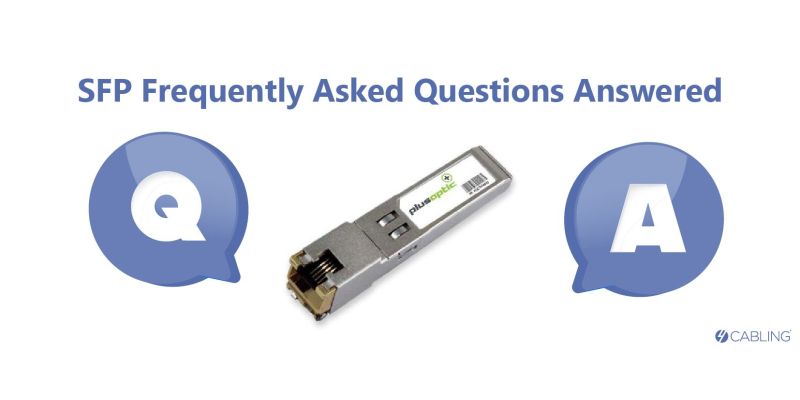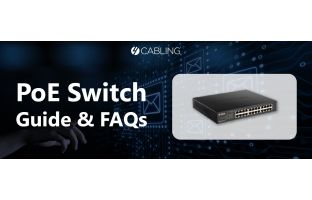Your SFP Frequently Asked Questions Answered
With the launch of our extended range of SFP modules, we’ve received an influx of questions; what is an SFP module used for, how do SFP modules work, and how to remove SFP modules from your set up?
Whether you need help learning how to choose SFP modules for your network, or how you can integrate them efficiently for best performance, read on. We’ve combined the most common questions and answers in this article to make your selection and set up of SFP modules seamless for best performance.
What is an SFP Module?
In short, SFP stands for Small Form-Factor Pluggable. An SFP module is a compact, hot-pluggable transceiver that is used within networking for high-speed data communication applications. You could consider it to be the powerhouse that connects your networking devices, which allows them to communicate over various optical or copper cables.
What are SFP modules used for?
SFP modules are extremely versatile, and can be used whether you’re setting up a small office spare or an industrial data centre. They're commonly used in networking equipment like switches, routers, and network interface cards.
Here are some common instances where SFP modules are used:
- Data centres: SFP modules are great for commercial or industrial data centres as they facilitate high-speed connectivity between networking equipment, including switches and routers.
- To connect wireless access points: Whether you’re operating a home or commercial Wi-Fi setup, SFP modules effectively connect wireless access points to the network.
- Surveillance systems: SFP modules play a crucial role in IP surveillance systems by connecting IP cameras to the network. This means you will recieve high-quality, real-time video streaming, and is great for locations without the limitations of traditional cabling.
- Industrial equipment: They connect various automation devices and controllers, contributing to the efficiency and automation of manufacturing processes.
How do SFP modules work?
The magic of SFP modules lies in their ability to convert electrical signals for cables. For example, when data needs to be transmitted, the SFP module in the server will convert the electrical signals into optic signals. The module’s function in the switch is to receive and then translate the data, transmitting over fibre-optic cables. Alternatively, for wireless transmission, the SFP module will leverage electrical signals for shorter-distance over copper SFP modules and copper cables.
Are SFP modules universal?
While SFP modules have the capability to adhere to a standardised form factor, they unfortunately aren’t universal. This is limited by several factors including cable type, data rate and wavelength.
The main example of limited interchangeability is because SFP modules designed for fibre-optic cables may not be compatible with copper cables, and vice versa.
However, while SFP modules and SFP cables may not be universal, this doesn’t mean that they aren’t compatible with various devices. Many switches and routers are designed to support a range of SFP modules including single mode SFP modules and multi mode SFP modules.
Do SFP modules have to match?
In short, yes. Your SFP modules should match with your networking equipment and cables in order to ensure optimal performance. For example, your module should match the specifications including data rate, wavelength and cable type, being either fiber-optic or copper. If you use mismatched equipment, you are increasing the risk of communication errors, reduced data transfer speeds, or incompatibility. This could lead to a multitude of troubleshooting problems down the track.
Are SFP modules hot swappable?
Yes, SFP modules are hot-swappable.
What is hotswapping? It means is that you can replace or install your SFP modules into your networking set up without having to shut down the entire system. Consider this like changing a tire on a moving car, but for your network. This means that you have more flexibility to scale your network, change out any old software and minimise downtown when you're performing maintenance or upgrades in your system.
How many SFP modules do I need?
The number of SFP modules that you need depends entirely on the size and scale of your network. Key consideration factors include the number of devices you need to connect, the distance between them for functionality, and the types of cables you will be using, for whether they are fibre-optic or copper.
How do I choose the right SFP modules?
You should consider several factors when you’re choosing SFP modules, including:
- Network requirements: Identify your data rate needs, cable types (fibre or copper), and distances between devices. For example, consider if you require high-speed data transfer in a data center, as you might need modules that support 10 Gbps or higher.
- Compatibility with devices: For instance, if you have a switch that supports 1 Gbps SFP modules, choose modules that align with this requirement.
- Fibre type: If you are currently using fibre-optic cables, consider the type of fibre (single-mode or multimode) based on the distance and environment. For instance, multimode fibre is suitable for shorter distances within buildings.
- Consider temperature and environmental factors: If you’re going to be implementing your SFP modules in harsh environments, select equipment that can withstand temperature variations and environmental challenges.
If you have any further questions, or would like to speak to a team member from 4Cabling on the specific needs of your set up, contact us. We’re more than happy to help provide product recommendations and help your network perform as efficiently as possible.






